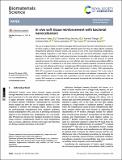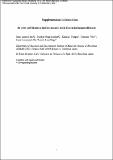Por favor, use este identificador para citar o enlazar a este item:
http://hdl.handle.net/10261/243545COMPARTIR / EXPORTAR:
 SHARE
BASE SHARE
BASE
|
|
| Visualizar otros formatos: MARC | Dublin Core | RDF | ORE | MODS | METS | DIDL | DATACITE | |

| Título: | In vivo soft tissue reinforcement with bacterial nanocellulose |
Autor: | Anton Sales, Irene; Roig Sánchez, Soledad; Traeger, Kamelia; Weis, Christine; Laromaine, Anna CSIC ORCID; Turon, Pau; Roig Serra, Anna CSIC ORCID | Palabras clave: | Polypropylene mesh Hernia repair Cellulose Coatings |
Fecha de publicación: | 21-abr-2021 | Editor: | Royal Society of Chemistry (UK) | Citación: | Biomaterials Science 9(8): 3040-3050 (2021) | Resumen: | The use of surgical meshes to reinforce damaged internal soft tissues has been instrumental for successful hernia surgery; a highly prevalent condition affecting yearly more than 20 million patients worldwide. Intraperitoneal adhesions between meshes and viscera are one of the most threatening complications, often implying reoperation or side effects such as chronic pain and bowel perforation. Despite recent advances in the optimization of mesh porous structure, incorporation of anti-adherent coatings or new approaches in the mesh fixation systems, clinicians and manufacturers are still pursuing an optimal material to improve the clinical outcomes at a cost-effective ratio. Here, bacterial nanocellulose (BNC), a bio-based polymer, is evaluated as a soft tissue reinforcement material regarding mechanical properties and in vivo anti-adhesive performance. A double-layer BNC laminate proved sufficient to meet the standards of mechanical resistance for abdominal hernia reinforcement meshes. BNC-polypropylene (BNC-PP) composites incorporating a commercial mesh have also been prepared. The in vivo study of implanted BNC patches in a rabbit model demonstrated excellent anti-adherent characteristics of this natural nanofibrous polymer 21-days after implantation and the animals were asymptomatic after the surgery. BNC emerges as a novel and versatile hernioplasty biomaterial with outstanding mechanical and anti-adherent characteristics. | Versión del editor: | http://dx.doi.org/10.1039/d1bm00025j | URI: | http://hdl.handle.net/10261/243545 | ISSN: | 2047-4830 |
| Aparece en las colecciones: | (ICMAB) Artículos |
Ficheros en este ítem:
| Fichero | Descripción | Tamaño | Formato | |
|---|---|---|---|---|
| Anton_BiomSci_2021-editorial.pdf | Artículo principal | 3,74 MB | Adobe PDF |  Visualizar/Abrir |
| Anton_BiomSci_2021-suppl_editorial.pdf | Información complementaria | 552,21 kB | Adobe PDF |  Visualizar/Abrir |
| Anton_BiomSci_2021-video.mp4 | Vídeo | 7,42 MB | mp4 | Visualizar/Abrir |
CORE Recommender
Page view(s)
47
checked on 22-abr-2024
Download(s)
146
checked on 22-abr-2024
Google ScholarTM
Check
Este item está licenciado bajo una Licencia Creative Commons

